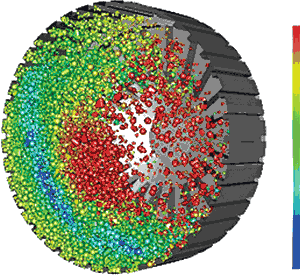|
DISCRETE ELEMENT
METHOD
|
What is DEM?
 DEM is a mathematical modeling technique that applied to communition
uses Newton's second law - kinematics - to calculate the position of each
elements - balls and ore particles of all sizes - as they are
affected by each other and in contact with liners, lifters and grates. The
first DEM models for milling were 2D and viewed the charge motion as a cross
sectional slice of the cylindrical mill. The models improved into 3 space
which included the effects of the cone shaped mill ends on particle motion.
Recent improvements, a visual example displayed to the right, have incorporated
other modeling methods such as computational fluid dynamics and discrete
grain
DEM is a mathematical modeling technique that applied to communition
uses Newton's second law - kinematics - to calculate the position of each
elements - balls and ore particles of all sizes - as they are
affected by each other and in contact with liners, lifters and grates. The
first DEM models for milling were 2D and viewed the charge motion as a cross
sectional slice of the cylindrical mill. The models improved into 3 space
which included the effects of the cone shaped mill ends on particle motion.
Recent improvements, a visual example displayed to the right, have incorporated
other modeling methods such as computational fluid dynamics and discrete
grain